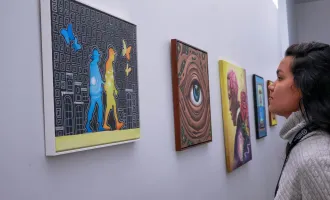
Art Meets Science For Dior Restoration
Editor's Note: This is part 4 of the limited series on the celebrated haute couture designer, Christian Dior.
A “toile” or “muslin” is a “mockup,” or prototype, for a garment design, usually made of an inexpensive white cloth. After all necessary fitting and draping adjustments are made on the toile, it is then used as a pattern guide when working with the final fabric.
“Timeless” is the word often used to describe Christian Dior, and it’s not without good reason. His designs — and the entire House of Dior itself — represent elegance and craftsmanship, ideals that stand tall no matter how many years have passed.
However, no object, not even an original Dior piece in all its glory, is resistant to the physical consequences of aging.
With time, dust begins to gather in the folds. Fine layers of grime begin to settle on the sequins. And in some areas, threads begin to fray.
Many of these changes may not be noticeable to the untrained eye, but if left unattended, may progress to more severe deteriorations.
At best, they can make a garment look dull or worn out, which is completely unfitting to the image of Christian Dior as “timeless.”
Thus, in 2017, Paris’s Musée des Arts Décoratifs had a big job on their hands in terms of textile restoration — the museum was putting together a huge exhibition, named “Christian Dior, Couturier du rêve,” or “Christian Dior, Designer of Dreams,” to honor the House of Dior’s 70th anniversary.
To prepare the exhibition’s showpieces, the museum’s restoration lab got to work. There were around 700 Dior-related pieces at the Musée, including accessories, along with pieces on loan from other museums.
Due to their age, many of them were fragile and required precise, detailed restoration. In a recent documentary of the exhibition, the Musée conservation team offered a deeper insight into the challenges of restoring antique textiles.
“Historic textiles are virtually the most fragile and the most complicated to display,” Musée textile conservator Emmanuelle Garcin said in the documentary. “[We use] surgical spatulas, scalpels — you find them in the domain of surgery, in couture, and in science. We’ll borrow things from all over.”
Considering the intricacy of repairing delicate micro-deteriorations, it’s easy to see why surgical instruments are widely used in the Musée lab — and in textile conservation in general.
A metal probe or a pair of fine-point tweezers can easily get at, say, tiny holes in a piece of fabric. And the lab has a wide array of other tools as well, such as suture needles, pliers, paintbrushes, and microscopes, for manipulating small details.
But for issues around restoring and maintaining a garment’s structure, there are other devices at the lab’s disposal.
Heat techniques, such as pressing and steaming, are usually not preferred for such circumstances, as they can accelerate fiber degradation.
Instead, the lab prefers to use cold techniques, such as cool-mist ultrasonic humidifiers, when reshaping delicate pieces.
For instance, in the video, a Musée conservator uses such a method to reinforce the structure of a Dior coat, which is adorned with a large tulle flower in the collar.
Along with tiny pins to temporarily “anchor” the flower in place, the humidity helps to “open up” the fabric, restoring some volume to the collar and its adornment.
Other types of lab equipment can be used for other purposes in textile conservation, such as cleaning. After the exhibition, for example, Junon (a 1949 original Dior ballgown) was returned to her home at the San Francisco De Young Museum.
To clean the gown’s sequins, which were slightly different from those of Venus (Junon’s “sister” ballgown), the museum’s textile conservation lab used a variable-suction, HEPA-filtered vacuum, in addition to manually cleaning the embellishments by hand.
And to further prevent sequin loss, as with Venus for her travel to France, the team performed as much of this restoration work as possible with the dress mounted on a dummy.
“The aim is to be able to display these pieces now,” says Garcin. “But we must also look after them in order to be able to display them in a century, or in a couple of centuries. That is the purpose of a museum — to share with others and to conserve. At times, it’s a bit of a contradiction.”
Taking into account the work of textile conservation, it is therefore clear that science does play a role in art, though this link is often overlooked.
However, the overlap is visible in another interesting way. Towards the end of the documentary, we see footages of the actual opening visit of the Dior exhibition. In one scene, the patrons are led to one of the “rooms” — the “Les Ateliers,” in which a number of toiles, or muslins, are on display.
And in front of them stands a small group of people — all wearing knee-length white doctoral coats, and beaming proudly at the visitors.
But they are not doctors. In fact, they are not healthcare professionals at all. Rather, they are the artisans of Dior — the highly talented, cherished sewers that bring the couture designs to life, all by manual effort. The “petites mains,” or “little hands.”
They are artists, but like scientists, they too wear white coats. It is the uniform they wear as they spend hours in the atelier, crafting couture pieces with the same utmost care and precision as that of a good doctor with his or her patients.
However, the Dior tailors are not the only ones in fashion who wear white coats, and the attire is not a recent introduction, either.
The white coat has actually been around in the couture workplace for years. Christian Dior himself often wore a white coat when working in the studio, and the same can be said for his direct successor, Yves Saint-Laurent.
In this regard, very little has changed. Today, white coats are still often the standard work attire amongst haute couture tailors in general, showing that the tradition has long since endured.
Thus, in both science and fashion, the white coat symbolizes professionalism, cleanliness, and authority, amongst many others.
Not just anybody in science can don a true white coat. And similarly, not just any tailor can wear a white coat.
It is reserved only for the ones with the most skill and expertise, the best of the best — the ones entrusted to create pieces for haute couture fashion houses, like the House of Dior.
Back in the video, a few of the high-profile patrons greet the tailors, engaging in conversation and shaking a few hands.
Nearby, more visitors mill around, staring in wonder at the toiles. As “test patterns,” the toiles are not the finished garments; yet, they are beautiful, showing the immense artistry and skill that haute couture demands.
Meanwhile, the white-coated tailors smile, proud to stand by their work in materializing Dior’s visions.
Science is in art, and art is in science.
The two work closely together, and some may not realize it. From this documentary, though, it is clear that the two are not completely separate pieces.
Like a conservator appraising a piece, or a Dior tailor examining her handiwork, you just have to look closer to find the seams.
Next week, we take a look at the infamous designers who took the helm as artistic directors for Dior.



